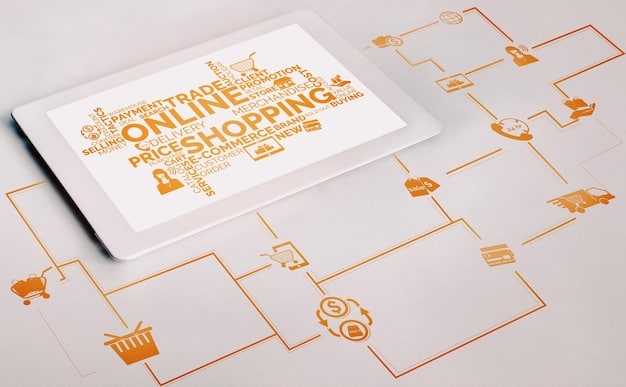E-commerce Marketing Automation: Your 2025 Strategy for Success

E-commerce Marketing Automation: Streamlining Your Marketing Efforts for Maximum Impact in 2025 involves using software to automate repetitive tasks, allowing businesses to personalize customer experiences and improve efficiency, ultimately driving sales and growth.
In the ever-evolving landscape of e-commerce, staying ahead of the curve is crucial. As we look toward 2025, e-commerce marketing automation: streamlining your marketing efforts for maximum impact in 2025 is no longer just a buzzword; it’s a necessity for businesses aiming to optimize their operations and enhance customer engagement. By leveraging the power of automation, e-commerce businesses can create personalized experiences, improve efficiency, and ultimately drive sales.
This article will explore the various facets of e-commerce marketing automation and how you can implement these strategies to achieve maximum impact in 2025, ensuring your business thrives in a competitive digital market.
Understanding the Basics of E-commerce Marketing Automation
E-commerce marketing automation refers to the use of software and technologies to automate repetitive marketing tasks. This allows businesses to deliver personalized and timely messages to customers, enhancing their overall shopping experience. E-commerce Marketing Automation: Streamlining Your Marketing Efforts for Maximum Impact in 2025 focuses on optimizing these automated processes to achieve maximum efficiency and impact.
Key Components of E-commerce Marketing Automation
Several key components make up an effective e-commerce marketing automation system. These include:
- Email Marketing: Automating email campaigns to nurture leads, welcome new subscribers, and promote products.
- Customer Segmentation: Grouping customers based on their behaviors, demographics, and purchase history to deliver targeted messages.
- Personalized Recommendations: Offering product recommendations based on individual customer preferences and browsing history.
- Behavioral Triggers: Sending automated messages based on specific customer actions, such as abandoned carts or website visits.
Effective e-commerce marketing automation hinges on understanding and strategically implementing these components. By automating these tasks, businesses can free up valuable time and resources, allowing them to focus on other critical areas such as product development and customer service. This ultimately contributes to a more efficient and profitable e-commerce operation. The integration of these components ensures that e-commerce marketing automation: streamlining your marketing efforts for maximum impact in 2025 maximizes impact.

The Benefits of Implementing E-commerce Marketing Automation
Implementing e-commerce marketing automation offers a plethora of benefits for businesses. From enhancing customer engagement to boosting sales and improving overall efficiency, the advantages are significant. Focusing on e-commerce marketing automation: streamlining your marketing efforts for maximum impact in 2025 can lead to remarkable improvements.
Increased Efficiency and Productivity
Automation reduces the time and resources required for repetitive marketing tasks, allowing your team to focus on more strategic initiatives. By automating email campaigns, social media posts, and other routine activities, you can improve productivity and streamline your workflow.
Improved Customer Engagement and Personalization
Automation enables you to deliver personalized content and offers to your customers based on their individual behaviors and preferences. This level of personalization enhances customer engagement and fosters stronger relationships, leading to increased loyalty and repeat purchases.
Higher Conversion Rates and Sales
By targeting customers with relevant and timely messages, automation can significantly improve conversion rates and drive sales. Abandoned cart emails, personalized product recommendations, and other automated tactics can encourage customers to complete their purchases and increase your revenue.
Investing in e-commerce marketing automation: streamlining your marketing efforts for maximum impact in 2025 is an investment in your business’s future. The returns on this investment are not only seen in increased sales but also in the overall improvement of your operational efficiency and customer satisfaction. Prioritizing these benefits will set your e-commerce business up for sustained success.
Setting Up Your E-commerce Marketing Automation System
Setting up an e-commerce marketing automation system involves several steps, from choosing the right tools to integrating them effectively with your existing platforms. To leverage e-commerce marketing automation: streamlining your marketing efforts for maximum impact in 2025 successfully, follow these guidelines.
Choosing the Right Marketing Automation Tools
Selecting the right marketing automation tools is crucial for the success of your strategy. Consider the following factors when making your decision:
- Integration Capabilities: Ensure that the tools integrate seamlessly with your existing e-commerce platform, CRM, and other marketing tools.
- Scalability: Choose tools that can scale with your business as you grow and expand your marketing efforts.
- User-Friendliness: Opt for tools that are intuitive and easy to use, reducing the learning curve for your team.
Integrating Automation with Your E-commerce Platform
Seamless integration with your e-commerce platform is essential for accurate data collection and effective automation. This integration allows you to track customer behavior, personalize messages, and trigger automated actions based on specific events.
Creating Effective Automated Workflows
Designing effective automated workflows is key to achieving your marketing goals. These workflows should be tailored to your specific business needs and customer segments, delivering targeted messages that resonate with your audience. By carefully planning and executing these workflows, you can maximize the impact of your e-commerce marketing automation efforts and ensure that e-commerce marketing automation: streamlining your marketing efforts for maximum impact in 2025 is truly beneficial.

Advanced Strategies for E-commerce Marketing Automation
Once you have the basics in place, you can explore advanced strategies to take your e-commerce marketing automation efforts to the next level. These strategies can help you further personalize customer experiences, optimize your campaigns, and drive even greater results. Implementing these strategies helps improve e-commerce marketing automation: streamlining your marketing efforts for maximum impact in 2025.
A/B Testing and Optimization
Conducting A/B tests on your automated messages and workflows can help you identify what works best for your audience. Test different subject lines, email content, and call-to-action buttons to optimize your campaigns and improve conversion rates. Continuously refine your approach based on the results of your tests.
Dynamic Content Personalization
Use dynamic content to personalize your messages based on customer data and behavior. This could include displaying different product recommendations, offers, or content based on their past purchases, browsing history, or demographic information. Dynamic content can significantly enhance customer engagement and drive sales.
Predictive Analytics and AI
Leverage predictive analytics and artificial intelligence (AI) to anticipate customer needs and behaviors. AI-powered tools can analyze vast amounts of data to identify patterns and trends, allowing you to deliver highly targeted and personalized messages at the perfect time. AI is key for ensuring the best e-commerce marketing automation: streamlining your marketing efforts for maximum impact in 2025.
By incorporating these advanced strategies into your e-commerce marketing automation efforts, you can create a truly personalized and effective customer experience. This not only drives sales but also builds lasting relationships with your customers, fostering loyalty and advocacy for your brand.
Measuring the Success of Your E-commerce Marketing Automation
Measuring the success of your e-commerce marketing automation efforts is essential for understanding what’s working and identifying areas for improvement. By tracking key metrics and analyzing your results, you can optimize your campaigns and maximize your ROI. It’s important to continually measure if that e-commerce marketing automation: streamlining your marketing efforts for maximum impact in 2025 is working.
Key Performance Indicators (KPIs) to Track
Several key performance indicators (KPIs) can help you measure the success of your e-commerce marketing automation. These include:
- Conversion Rates: Track the percentage of customers who complete a purchase after interacting with your automated messages.
- Click-Through Rates (CTR): Monitor the percentage of customers who click on links in your automated emails and other messages.
- Open Rates: Measure the percentage of customers who open your automated emails.
- Customer Lifetime Value (CLTV): Assess the long-term value of customers acquired through your automation efforts.
Analyzing and Optimizing Your Campaigns
Regularly analyze your campaign performance and identify areas for improvement. Use A/B testing to optimize your messages, workflows, and targeting strategies. Continuously refine your approach based on the data and insights you gather. Continuous measuring and adjustments are part of ensuring effective e-commerce marketing automation: streamlining your marketing efforts for maximum impact in 2025.
Using Data to Drive Decision-Making
Data should be at the heart of your e-commerce marketing automation strategy. Use data to inform your decisions, personalize your messages, and optimize your campaigns. By leveraging data effectively, you can create a more targeted and effective marketing approach that drives results. Only data can show if the planned e-commerce marketing automation: streamlining your marketing efforts for maximum impact in 2025 is delivering results.
| Key Point | Brief Description |
|---|---|
| 🚀 Automation Basics | Use tools to automate marketing, personalize experiences, and save time. |
| 📈 Benefits | Efficiency, better engagement, higher sales—make the most of your marketing impacts. |
| 🛠️ Setting Up | Choose tools that integrate, scale, and streamline workflows for effective use. |
| 📊 Measuring Success | Analyze KPIs, A/B test to optimize campaigns, and use data for decisions. |
Frequently Asked Questions
It involves using software to automate tasks like email marketing and personalized recommendations, increasing efficiency and customer engagement.
Automation allows for personalized content delivery based on customer behavior, fostering stronger relationships and loyalty through relevance.
Important components include email marketing, customer segmentation, and behavioral triggers to deliver targeted experiences.
Consider integration capabilities, scalability, and user-friendliness to ensure tools meet your current and future business needs.
Track KPIs like conversion rates, click-through rates, and customer lifetime value to assess your campaign performance and ROI.
Conclusion
As we move closer to 2025, e-commerce marketing automation: streamlining your marketing efforts for maximum impact in 2025 will become even more critical for businesses looking to stay competitive. By understanding the basics, implementing effective strategies, and continuously measuring your results, you can harness the power of automation to drive sales, enhance customer engagement, and achieve long-term success.
Embrace the opportunities that e-commerce marketing automation offers and position your business for growth in the evolving digital landscape. The future of e-commerce relies on efficient, personalized, and automated marketing efforts, ensuring you remain a leader in the market.





